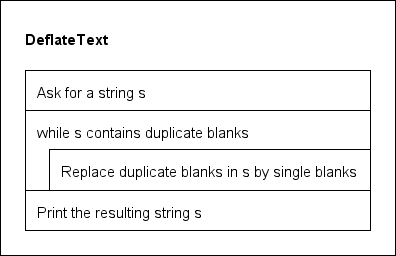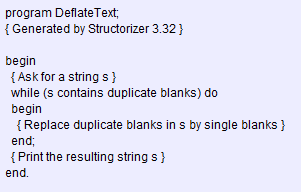|
Purist algorithm documenters often detest written code in Nassi-Shneiderman diagrams (and have their reasons to). They prefer pseudocode or even natural-language verbal descriptions of the steps to perform. In any case, it should be language-independent, where they mean that no specific programming language should be addressed.
On the other hand, verbal descriptions depend of course on some natural language and will usually be ambiguous.
We should be aware that algorithms are not restricted to mathematical or computational purposes. You might want to present an algorithm for building a house, for steering a car, for organising a wedding party, or whatsoever. Floating-point variables or trigonometric functions don't make sense there.
A possible purist (rather abstract) diagram for our (clearly computable) example task formulated in English might look like this:

This approach is intuitively clear though we don't know how exactly the occurrence of duplicate blanks is to be detected and how to do the replacement.
The purist might export the structure into certain programming language but then they are only interested in the translation of the structures and would like to preserve the elements texts, either by converting the instruction descriptions into comments or at least by suppressing any automatic attempts to transform the instruction syntax (since it is not executable code), e.g. the resulting Pascal export with the export preferences recommend below would look like this:

Most important activities:
Recommended preferences:
|

